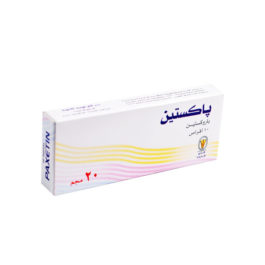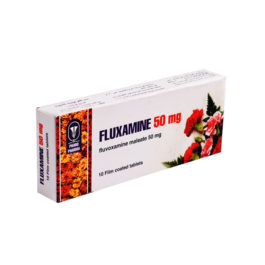Description
3. PHARMACEUTICAL FORM
Hard gelatin capsule
4. CLINICAL PARTICULARS
4.1. Therapeutic indications
– Management of neuropathic pain associated with diabetic peripheral neuropathy.
– Management of postherpetic neuralgia.
– Adjunctive therapy for adult patients with partial onset seizures.
– Management of fibromyalgia.
4.2. Posology and method of administration
The dose range is 150 to 600 mg per day given in either two or three divided doses.
Nervatin may be taken with or without food.
Neuropathic pain
Pregabalin treatment can be started at a dose of 150 mg per day. Based on individual patient response and tolerability, the dosage may be increased to 300 mg per day after an interval of 3 to 7 days, and if needed, to a maximum dose of 600 mg per day after an additional 7-day interval.
Epilepsy
Pregabalin treatment can be started with a dose of 150 mg per day. Based on individual patient response and tolerability, the dosage may be increased to 300 mg per day after 1 week. The maximum dosage of 600 mg per day may be achieved after an additional week.
Generalised Anxiety Disorder
The dose range is 150 to 600 mg per day given as two or three divided doses. The need for treatment should be reassessed regularly.
Pregabalin treatment can be started with a dose of 150 mg per day. Based on individual patient response and tolerability, the dosage may be increased to 300 mg per day after 1 week. Following an additional week the dosage may be increased to 450 mg per day. The maximum dosage of 600 mg per day may be achieved after an additional week.
Discontinuation of pregabalin
In accordance with current clinical practice, if pregabalin has to be discontinued it is recommended this should be done gradually over a minimum of 1 week independent of the indication (see section 4.8) Patients with renal impairment
Pregabalin is eliminated from the systemic circulation primarily by renal excretion as unchanged drug. As pregabalin clearance is directly proportional to creatinine clearance (see section 5.2), dosage reduction in patients with compromised renal function must be individualised according to creatinine clearance (Clcr), as indicated in Table 1 determined using the following formula:
[ 1.23 x [140 – age (years)] x weight (kg)]
CLcr(ml/min)= (x 0.85 for female patients)
serum creatinine (mol/l)
Pregabalin is removed effectively from plasma by haemodialysis (50% of drug in 4 hours). For patients receiving haemodialysis, the pregabalin daily dose should be adjusted based on renal function. In addition to the daily dose, a supplementary dose should be given immediately following every 4-hour haemodialysis treatment (see Table 1).
Table 1. Pregabalin dosage adjustment based on renal function.
Dose Regimen Creatinine
clearance (CLcr)
(mL/min)
Total Pregabalin Daily dose *
Maximum dose Starting dose
(mg/day) (mg/day)
BID or TID 600 150 60
BID or TID 300 75 30- <60
Once Daily or BID 150 25 - 50 15-<30
Once Daily 75 25 <15
Supplementary dosage following haemodialysis (mg)
Single dose + 100 25
TID = three divided doses
BID = Two divided doses
* Total daily dose (mg/day) should be divided as indicated by dose regimen to provide mg/dose
+ Supplementary dose is a single additional dose
Use in patients with hepatic impairment
No dosage adjustment is required for patients with hepatic impairment .
Use in children and adolescents
Nervatin is not recommended for use in children below the age of 12 years and adolescents (12 - 17 years of age) due to insufficient data on safety and efficacy.
Use In the elderly (over 65 years of age)
Elderly patients may require a dose reduction of pregabalin due to a decreased renal function (see patients with renal impairment).
4.3. Contraindications
Hypersensitivity to the active substance or to any of the excipients.
4.4. Special warnings and precautions for use
Angioedema
There have been postmarketing reports of angioedema in patients during initial and chronic treatment with pregabalin. Specific symptoms included swelling of the face, mouth (tongue, lips, and gums), and neck (throat and larynx). There were reports of life-threatening angioedema with respiratory compromise requiring emergency treatment. NERVATIN should be discontinued immediately in patients with these symptoms. Caution should be exercised when prescribing NERVATIN to patients who have had a previous episode of angioedema. In addition, patients who are taking other drugs associated with angioedema (e.g., angiotensin converting enzyme inhibitors [ACE-inhibitors]) may be at increased risk of developing angioedema.
Hypersensitivity
There have been postmarketing reports of hypersensitivity in patients shortly after initiation of treatment with pregabalin. Adverse reactions included skin redness, blisters, hives, rash, dyspnea, and wheezing. NERVATIN should be discontinued immediately in patients with these symptoms.
Withdrawal of Antiepileptic Drugs (AEDs)
As with all AEDs, NERVATIN should be withdrawn gradually to minimize the potential of increased seizure frequency in patients with seizure disorders. If NERVATIN is discontinued this should be done gradually over a minimum of 1 week.
Suicidal Behavior and Ideation
Antiepileptic drugs (AEDs), including NERVATIN, increase the risk of suicidal thoughts or behavior in patients taking these drugs for any indication. Patients treated with any AED for any indication should be monitored for the emergence or worsening of depression, suicidal thoughts or behavior, and/or any unusual changes in mood or behavior.
Anyone considering prescribing NERVATIN or any other AED must balance the risk of suicidal thoughts or behavior with the risk of untreated illness. Epilepsy and many other illnesses for which AEDs are prescribed are themselves associated with morbidity and mortality and an increased risk of suicidal thoughts and behavior. Should suicidal thoughts and behavior emerge during treatment, the prescriber needs to consider whether the emergence of these symptoms in any given patient may be related to the illness being treated.
Patients, their caregivers, and families should be informed that AEDs increase the risk of suicidal thoughts and behavior and should be advised of the need to be alert for the emergence or worsening of the signs and symptoms of depression, any unusual changes in mood or behavior, or the emergence of suicidal thoughts, behavior, or thoughts about self-harm. Behaviors of concern should be reported immediately to healthcare providers.
Peripheral Edema
NERVATIN treatment may cause peripheral edema. In short-term trials of patients without clinically significant heart or peripheral vascular disease, there was no apparent association between peripheral edema and cardiovascular complications such as hypertension or congestive heart failure. Peripheral edema was not associated with laboratory changes suggestive of deterioration in renal or hepatic function.
Higher frequencies of weight gain and peripheral edema were observed in patients taking both NERVATIN and a thiazolidinedione antidiabetic agent compared to patients taking either drug alone. The majority of patients using thiazolidinedione antidiabetic agents in the overall safety database were participants in studies of pain associated with diabetic peripheral neuropathy.
As the thiazolidinedione class of antidiabetic drugs can cause weight gain and/or fluid retention, possibly exacerbating or leading to heart failure, care should be taken when co-administering NERVATIN and these agents.
Because there are limited data on congestive heart failure patients with New York Heart Association (NYHA) Class III or IV cardiac status, NERVATIN should be used with caution in these patients.
Dizziness and Somnolence
NERVATIN may cause dizziness and somnolence. Patients should be informed that NERVATIN -related dizziness and somnolence may impair their ability to perform tasks such as driving or operating machinery.
Weight Gain
NERVATIN treatment may cause weight gain. NERVATIN associated weight gain was related to dose and duration of exposure, but did not appear to be associated with baseline BMI, gender, or age. Weight gain was not limited to patients with edema.
Abrupt or Rapid Discontinuation
Following abrupt or rapid discontinuation of NERVATIN, some patients reported symptoms including insomnia, nausea, headache, and diarrhea. NERVATIN should be tapered gradually over a minimum of 1 week rather than discontinued abruptly.
Ophthalmological Effects
Although the clinical significance of the ophthalmologic findings is unknown, patients should be informed that if changes in vision occur, they should notify their physician. If visual disturbance persists, further assessment should be considered. More frequent assessment should be considered for patients who are already routinely monitored for ocular conditions .
Creatine Kinase Elevations
NERVATIN treatment was associated with creatine kinase elevations. Mean changes in creatine kinase from baseline to the maximum value were 60 U/L for pregabalin -treated patients and 28 U/L for the placebo patients. Prescribers should instruct patients to promptly report unexplained muscle pain, tenderness, or weakness, particularly if these muscle symptoms are accompanied by malaise or fever. NERVATIN treatment should be discontinued if myopathy is diagnosed or suspected or if markedly elevated creatine kinase levels occur.
Decreased Platelet Count
NERVATIN treatment was associated with a decrease in platelet count. NERVATIN was not associated with an increase in bleeding-related adverse reactions.
PR Interval Prolongation
NERVATIN treatment was associated with PR interval prolongation.
4.5. Interaction with other medicinal products and other forms of interaction
Since pregabalin is predominantly excreted unchanged in the urine, undergoes negligible metabolism in humans (<2% of a dose recovered in urine as metabolites), does not inhibit drug metabolism in vitro and is not bound to plasma proteins, it is unlikely to produce, or be subject to, pharmacokinetic interactions.
Accordingly, in in vivo studies no clinically relevant pharmacokinetic interactions were observed between pregabalin and phenytoin, carbamazepine, valproic acid, lamotrigine, gabapentin, lorazepam, oxycodone or ethanol. Population pharmacokinetic analysis indicated that oral antidiabetics, diuretics, insulin, phenobarbital, tiagabine and topiramate had no clinically significant effect on pregabalin clearance.
Co-administration of pregabalin with the oral contraceptives norethisterone and/or ethinyl oestradiol does not influence the steady-state pharmacokinetics of either substance.
Multiple oral doses of pregabalin co-administered with oxycodone, lorazepam, or ethanol did not result in clinically important effects on respiration. Pregabalin appears to be additive in the impairment of cognitive and gross motor function caused by oxycodone. Pregabalin may potentiate the effects of ethanol and lorazepam.
No specific pharmacodynamic interaction studies were conducted in elderly volunteers. Interaction studies have only been performed in adults.
4.6. Pregnancy and lactation
There are no adequate data from the use of pregabalin in pregnant women.
Studies in animals have shown reproductive toxicity.
The potential risk to humans is unknown.
Nervatin should not be used during pregnancy unless clearly necessary (if the benefit to the mother clearly outweighs the potential risk to the foetus). Effective contraception must be used in women of child bearing potential.
It is not known if pregabalin is excreted in the breast milk of humans; however, it is present in the milk of rats. Therefore, breast-feeding is not recommended during treatment with pregabalin.
4.7. Effects on ability to drive and use machines
Nervatin may have minor or moderate influence on the ability to drive and use machines. Nervatin may cause dizziness and somnolence and therefore may influence the ability to drive or use machines. Patients are advised not to drive, operate complex machinery or engage in other potentially hazardous activities until it is known whether this medication affects their ability to perform these activities.
4.8. Adverse effects
Body as a Whole - Frequent: Abdominal pain, Allergic reaction, Fever, Infrequent: Abscess, Cellulitis, Chills, Malaise, Neck rigidity, Overdose, Pelvic pain, Photosensitivity reaction, Rare: Anaphylactoid reaction, Ascites, Granuloma, Hangover effect, Intentional Injury, Retroperitoneal Fibrosis, Shock
Cardiovascular System - Infrequent: Deep thrombophlebitis, Heart failure, Hypotension, Postural hypotension, Retinal vascular disorder, Syncope; Rare: ST Depressed, Ventricular Fibrillation
Digestive System - Frequent: Gastroenteritis, Increased appetite; Infrequent: Cholecystitis, Cholelithiasis, Colitis, Dysphagia, Esophagitis, Gastritis, Gastrointestinal hemorrhage, Melena, Mouth ulceration, Pancreatitis, Rectal hemorrhage, Tongue edema; Rare: Aphthous stomatitis, Esophageal Ulcer,Periodontal abscess
Hemic and Lymphatic System - Frequent: Ecchymosis; Infrequent: Anemia, Eosinophilia, Hypochromic anemia, Leukocytosis, Leukopenia, Lymphadenopathy, Thrombocytopenia; Rare: Myelofibrosis, Polycythemia, Prothrombin decreased, Purpura, Thrombocythemia
Metabolic and Nutritional Disorders - Rare: Glucose Tolerance Decreased, Urate Crystalluria
Musculoskeletal System - Frequent: Arthralgia, Leg cramps, Myalgia, Myasthenia; Infrequent: Arthrosis; Rare: Chondrodystrophy, Generalized Spasm
Nervous System - Frequent: Anxiety, Depersonalization, Hypertonia, Hypesthesia, Libido decreased, Nystagmus, Paresthesia, Stupor, Twitching; Infrequent: Abnormal dreams, Agitation, Apathy, Aphasia, Circumoral paresthesia, Dysarthria, Hallucinations, Hostility, Hyperalgesia, Hyperesthesia, Hyperkinesia, Hypokinesia, Hypotonia, Libido increased, Myoclonus, Neuralgia, Rare: Addiction, Cerebellar syndrome, Cogwheel rigidity, Coma, Delirium, Delusions, Dysautonomia, Dyskinesia, Dystonia, Encephalopathy, Extrapyramidal syndrome, Guillain-Barré syndrome, Hypalgesia, Intracranial hypertension, Manic reaction, Paranoid reaction, Peripheral neuritis, Personality disorder, Psychotic depression, Schizophrenic reaction, Sleep disorder, Torticollis, Trismus
Respiratory System - Rare: Apnea, Atelectasis, Bronchiolitis, Hiccup, Laryngismus, Lung edema, Lung fibrosis, Yawn
Skin and Appendages - Frequent: Pruritus, Infrequent: Alopecia, Dry skin, Eczema, Hirsutism, Skin ulcer, Urticaria, Vesiculobullous rash; Rare: Angioedema, Exfoliative dermatitis, Lichenoid dermatitis, Melanosis, Nail Disorder, Petechial rash, Purpuric rash, Pustular rash, Skin atrophy, Skin necrosis, Skin nodule, Stevens-Johnson syndrome, Subcutaneous nodule
Special senses - Frequent: Conjunctivitis, Diplopia, Otitis media, Tinnitus; Infrequent: Abnormality of accommodation, Blepharitis, Dry eyes, Eye hemorrhage, Hyperacusis, Photophobia, Retinal edema, Taste loss, Taste perversion; Rare: Anisocoria, Blindness, Corneal ulcer, Exophthalmos, Extraocular palsy, Iritis, Keratitis, Keratoconjunctivitis, Miosis, Mydriasis, Night blindness, Ophthalmoplegia, Optic atrophy, Papilledema, Parosmia, Ptosis, Uveitis.
Urogenital System - Frequent: Anorgasmia, Impotence, Urinary frequency, Urinary incontinence; Infrequent: Abnormal ejaculation, Albuminuria, Amenorrhea, Dysmenorrhea, Dysuria, Hematuria, Kidney calculus, Leukorrhea, Menorrhagia, Metrorrhagia, Nephritis, Oliguria, Urinary retention, Urine abnormality; Rare: Acute kidney failure, Balanitis, Bladder Neoplasm, Cervicitis, Dyspareunia, Epididymitis, Female lactation, Glomerulitis, Ovarian disorder, Pyelonephritis
Comparison of Gender and Race
The overall adverse event profile of pregabalin was similar between women and men. There are insufficient data to support a statement regarding the distribution of adverse experience reports by race.
4.9. Overdose
In overdoses up to 15 g, no unexpected adverse reactions were reported. Treatment of pregabalin overdose should include general supportive measures and may include haemodialysis if necessary.
5. PHARMACOLOGICAL PROPERTIES
5.1. Pharmacodynamic properties
Pharmacotherapeutic group: Antiepileptics.
The active substance, pregabalin, is a gamma-aminobutyric acid analogue ((S)-3-(aminomethyl)-5-methylhexanoic acid).
Mechanism of action
Pregabalin binds to an auxiliary subunit (2- protein) of voltage-gated calcium channels in the central nervous system, potently displacing [3H]-gabapentin.
5.2. Pharmacokinetic properties
Pregabalin steady-state pharmacokinetics are similar in healthy volunteers, patients with epilepsy receiving antiepileptic drugs and patients with chronic pain.
Absorption:
Pregabalin is rapidly absorbed when administered in the fasted state, with peak plasma concentrations occurring within 1 hour following both single and multiple dose administration. Pregabalin oral bioavailability is estimated to be ~90% and is independent of dose. Following repeated administration, steady state is achieved within 24 to 48 hours. The rate of pregabalin absorption is decreased when given with food resulting in a decrease in Cmax by approximately 25-30% and a delay in tmax to approximately 2.5 hours. However, administration of pregabalin with food has no clinically significant effect on the extent of pregabalin absorption.
Distribution:
In humans, the apparent volume of distribution of pregabalin following oral administration is approximately 0.56 l/kg. Pregabalin is not bound to plasma proteins.
Metabolism:
Pregabalin undergoes negligible metabolism in humans. Following a dose of radiolabelled pregabalin, approximately 98% of the radioactivity recovered in the urine was unchanged pregabalin. The N-methylated derivative of pregabalin, the major metabolite of pregabalin found in urine accounted for 0.9% of the dose. In preclinical studies, there was no indication of racemisation of pregabalin S-enantiomer to the R-enantiomer.
Elimination:
Pregabalin is eliminated from the systemic circulation primarily by renal excretion as unchanged drug.
Pregabalin mean elimination half-life is 6.3 hours. Pregabalin plasma clearance and renal clearance are directly proportional to creatinine clearance.
Dosage adjustment in patients with reduced renal function or undergoing haemodialysis is necessary .
Linearity / non-linearity:
Pregabalin pharmacokinetics are linear over the recommended daily dose range. Inter-subject pharmacokinetic variability for pregabalin is low (20%). Multiple dose pharmacokinetics are predictable from single-dose data. Therefore, there is no need for routine monitoring of plasma concentrations of pregabalin.
Pharmacokinetics in special patient groups
Gender
Clinical trials indicate that gender does not have a clinically significant influence on the plasma concentrations of pregabalin.
Renal impairment
Pregabalin clearance is directly proportional to creatinine clearance. In addition, pregabalin is effectively removed from plasma by haemodialysis (following a 4 hour haemodialysis treatment plasma pregabalin concentrations are reduced by approximately 50%). Because renal elimination is the major elimination pathway, dosage reduction in patients with renal impairment and dosage supplementation following haemodialysis is necessary.
Hepatic impairment
No specific pharmacokinetic studies were carried out in patients with impaired liver function. Since pregabalin does not undergo significant metabolism and is excreted predominantly as unchanged drug in the urine, impaired liver function would not be expected to significantly alter pregabalin plasma concentrations.
Elderly (over 65 years of age)
Pregabalin clearance tends to decrease with increasing age. This decrease in pregabalin oral clearance is consistent with decreases in creatinine clearance associated with increasing age. Reduction of pregabalin dose may be required in patients who have age related compromised renal function .
6. PHARMACEUTICAL PARTICULARS
6.1. List of excipients
Capsule content:
Lactose monohydrate, Maize starch, Talc powder
6.5. Nature and contents of container
Nervatin 150 capsules: Carton box containing one PVC/Aluminium strip of 10 hard gelatin capsules.
Nervatin 75 capsules: Carton box containing two PVC/Aluminium strips, each of 10 hard gelatin capsules.
STORAGE:
Keep at a temperature not exceeding 30C, in dry place.
Keep out of reach of children.








Reviews
There are no reviews yet.